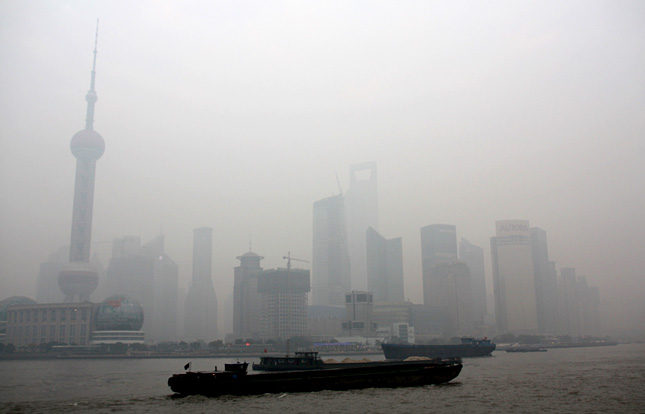-
Greener Ports for Bluer Skies in China
October 24, 2016 By Cameron Hickert
If China is the globe’s most powerful manufacturing engine, the port of Shanghai is its fuel injection valve. This harbor is the world’s busiest, both in terms of tonnage and number of containers processed, allowing China to import the raw materials fueling its development and export the products that represent a significant share of the world’s economy.
But for more than 50 days in 2014, the port fell silent. Low visibility from intense smog prevented ships from entering or exiting and motivated China’s Maritime Safety Administration to start using satellite data to assist in directing traffic.
Ports have emerged as a new front in China’s “war on air pollution.” The Wilson Center’s China Environment Forum has undertaken the task of analyzing these changes through the Choke Point: Port Cities initiative, conducted in partnership with the reporters at Circle of Blue. This effort includes multimedia reporting on the challenges and opportunities facing ports in China and their counterparts in the United States. This summer, after issuing a joint report with the International Council on Clean Transportation regarding shore power provided to ships at the port of Shenzhen, the China Environment Forum convened a panel discussion on “green port” management at the Wilson Center.
Missing the Boat
“If global shipping were a nation unto itself, it would be the world’s sixth largest polluter,” said Tony Padilla, a senior advisor for international affairs at the U.S. Department of Transportation’s Maritime Administration. Port throughput in China has increased 500 percent over the past 15 years. And because low-grade marine fuel oil contains 3,500 times more sulfur than road diesel, this increase has had significant effects on air pollution.
24,000 premature deaths annually in East Asia are related to particulate emissions from shippingPeng Chuansheng of the China Waterborne Transport Institute, a research arm of China’s Ministry of Transport, estimated that a “container ship running at 70 percent of maximum power for one day emits as much PM2.5 pollution [a form of particulate matter] each day as almost 300,000 new trucks.”
Geography is also important. Container ports are often near bustling urban centers. This amplifies the toxic effects of pollution. Estimates hold that 24,000 premature deaths annually in East Asia are related to particulate emissions from shipping, with the greatest impact falling on China’s densely populated coast. China is home to 7 of the top 10 busiest ports in the world, and population density along the coast, with megacities like Shanghai, Shenzhen, and Qingdao, is 450 people per square kilometer (compared to 69 in the United States).
Ignoring shipping pollution is an untenable policy for any major port city. Hong Kong sought to tackle air pollution with policies focused solely on land-based sources. The result? Between 1997 and 2014, the city failed to meet particulate matter air quality objectives at 12 of 14 monitoring stations, and marine PM2.5 emissions ballooned from 17 to 42 percent of overall pollution emissions.
Tightening Up the Ship
China’s Ministry of Transport has become aware of these realities and launched a response. The new strategy is one in which stringent new emission regulations have the teeth necessary to cause change. The Specialized Action Plan of Ship and Port Pollution and Control from 2015 to 2020 is representative of this new front.
 The 2015-2020 action plan utilizes emission control areas, or ECAs, to reduce pollution in specific locations. An ECA is a region of the sea, often near major urban centers, in which vessels must reduce their emissions to specified limits. The Ministry of Transport announced mainland China’s first ECAs for the Yangtze River Delta (implemented April 1, 2016), the Pearl River Delta (to be implemented January 1, 2017), and the Bohai Sea (also to be implemented January 1, 2017).
The 2015-2020 action plan utilizes emission control areas, or ECAs, to reduce pollution in specific locations. An ECA is a region of the sea, often near major urban centers, in which vessels must reduce their emissions to specified limits. The Ministry of Transport announced mainland China’s first ECAs for the Yangtze River Delta (implemented April 1, 2016), the Pearl River Delta (to be implemented January 1, 2017), and the Bohai Sea (also to be implemented January 1, 2017).To reduce emissions, the ECA approach is twofold. The first component is fuel switching. Once a ship enters the designated zone, it must shift to lower-sulfur fuel that reduces three harmful pollutants: particulate matter, sulfur oxides, and nitrogen oxides. One alternative fuel the plan specifically encourages is liquefied natural gas. By 2019, all ships traveling and docking in ECAs must shift from the current average of 2.5 percent sulfur fuel to a maximum of 0.5 percent sulfur fuel. The 2015-2020 action plan further obligates the Ministry of Transport to consider whether to reduce the upper limit to 0.1 percent by the end of 2019.
The second component of ECAs is onshore power. Container ships are massive vessels that require a significant amount of time at port simply to load, unload, and perform maintenance. During these periods vessels continue to burn fuel to power onboard equipment and facilities. Shore power, however, is the process by which docking vessels can connect to the port city’s power grid. Because land-based energy sources are subject to stricter emissions regulations and can benefit from economies of scale, onshore power generally leads to net reductions in vessel emissions. The 2015-2020 action plan calls for 90 percent of China’s major ports to use onshore power for berthing by 2020.
Out of the Smog, Into the Light?
Of course, the success of these policies hinges on successful implementation. Although fuel with a lower sulfur content is slightly more expensive, it appears shipping companies prefer the establishment of ECAs to shipping moratoriums of the type instituted in Shanghai in 2014 when the smog became unnavigable. In addition, while onshore power should theoretically come from a cleaner process than burning diesel, China is still heavily reliant on coal power. The impact of this method rests on a broader effort to change China’s energy mix.
Enforcement is another potential problem. The sheer number of vessels in China’s ports defies imagination, and inspecting enough to provide ample deterrent against those who would ignore the law is easier said than done. This task will fall to subsidiaries of China’s Maritime Safety Administration (MSA), said Freda Fung of the Natural Resources Defense Council. “The challenge is that the number of ships visiting Chinese ports is so large that MSA can’t check all of them because MSA has very limited human resources.”
Since establishing an ECA, Hong Kong has slashed sulfur dioxide emissions by more than 50%Still, the benefits of effective green port policies are enticingly clear. Since establishing its own ECA with a 0.5 percent sulfur fuel limit in July 2015, Hong Kong has already slashed sulfur dioxide emissions by more than 50 percent in areas surrounding its port.
Local efforts are lent momentum from beyond the nation’s borders. The U.S.-China Strategic and Economic Dialogue highlighted the problem at the highest level this summer with the Green Ports and Vessel Initiative, which “adopted a work plan establishing priorities, activities, and anticipated achievements to reduce emissions of air pollutants and black carbon and achieve climate co-benefits.”
And ports themselves are collaborating across the Pacific. In 2014, the port of Los Angeles and the port of Shanghai built on previous experience working together to launch an “EcoPartnership,” a “formal agreement to exchange information, technical expertise, and best practices to expand use of shore power at the port of Shanghai.” Ports in Seattle and Dalian arranged a similar partnership in 2009. Officials on both shores of the Pacific hope this type of cooperation will accelerate China’s ability to achieve ECA compliance.
When smog is overwhelming, guiding a shipping vessel through the port of Shanghai is a treacherous feat. Yet its most deadly effects – on people’s health – are not immediately clear. The effort to green China’s ports is a major effort in the government’s ongoing war on pollution, not only to clean up the country’s skies, but also to protect the lives of millions of people.
Cameron Hickert is a Schwarzman scholar at Beijing’s Tsinghua University, where he researches the impacts of China’s rise. He was a summer 2016 research assistant with the China Environment Forum.
Sources: City of Los Angeles, Government of the Hong Kong Special Administrative Region, Ministry of Transport (China), Nature, Nature Climate Change, U.S. Department of State.
Photo Credit: Shanghai skyline, courtesy of flickr user maerzbow. Map: the Yangtze River Delta, Pearl River Delta, and Bohai Sea ECAs, courtesy of the Ministry of Transport (China).
 A Publication of the Stimson Center.
A Publication of the Stimson Center.

 The 2015-2020 action plan utilizes emission control areas, or ECAs, to reduce pollution in specific locations. An ECA is a region of the sea, often near major urban centers, in which vessels must reduce their emissions to specified limits. The Ministry of Transport
The 2015-2020 action plan utilizes emission control areas, or ECAs, to reduce pollution in specific locations. An ECA is a region of the sea, often near major urban centers, in which vessels must reduce their emissions to specified limits. The Ministry of Transport 





